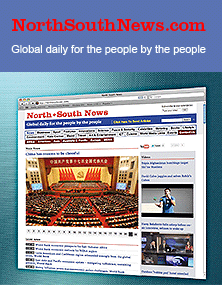[Published: Saturday November 09 2024]
 Look before we leap: peace, security and the second quantum revolution
STOCKHOLM, 09 Nov. - (ANA)- We are on the cusp of a second quantum revolution, according to a paper by Dr Alexander Blanchard published by SIPRI.
The first saw the advent of world-changing technologies like nuclear fission, lasers and semiconductors. The second, which exploits the behaviour of individual quantum systems, promises to transform technologies for sensing, imaging, navigation, computing, information science, communications and many other applications. Some of these advances will soon be mature enough to be adopted at scale. This has profound implications for a wide range of fields, including global peace and security.
The second quantum revolution could have many benefits for peace and security. For instance, advances in quantum sensing could provide better detection of chemical, biological, radiological and nuclear hazards and threats. Moreover, quantum computing could bring about advances in climate modelling and monitoring, allowing us to better forecast the long-term effects of climate change.
But this coming revolution could also introduce substantial risks. Advances in quantum computing could, for example, undermine current encryption methods on which digital information security depends, including for communications and financial transactions. New quantum technologies could bring advances to several critical industries tied closely to global peace and security, such as semiconductor research and development, thereby instigating a race to securitize these technologies. These risks—many of which we barely understand and some, undoubtedly, that we cannot anticipate—require governance responses, including at the multilateral level. It is high time to set this in motion.
New capabilities, new risks
As my colleagues and I argued in a recent comment article in Nature, many of the peace and security risks posed by quantum technologies are likely to derive from their use in a national security context, particularly by the military. Quantum technologies offer significant opportunities to enhance existing and future capabilities, including in data collection, intelligence analysis, secure communications and the development of weapons and materials. For example, quantum sensors may be able to detect objects underground and underwater (such as submarines, missile siloes and underground research facilities) that would be invisible to conventional satellite sensors.
Quantum sensors could also be used to enhance navigation; field testing has already begun on so-called quantum compasses, which use a quantum accelerometer to measure the velocity of super-cooled atoms. Quantum compasses could enable accurate navigation, something particularly valuable for conducting military operations in environments where the global positioning system (GPS) cannot be used, whether due to poor weather or enemy action.
Quantum technologies for military applications are attracting substantial interest and investment. This year, NATO developed a Quantum Technologies Strategy calling on the alliance to be ‘quantum-ready’. In 2023, the United States Department of Defense launched a $45 million initiative to integrate quantum components into weapons systems in order to enhance targeting precision.
US lawmakers are currently pushing for the creation of a centre of excellence on quantum computing, focused on developing military applications and building the US military’s capabilities in this field. The British Ministry of Defence acquired a quantum computer in 2022.
It has also invested in quantum sensors and clocks. India’s Ministry of Defence is investing in quantum key distribution (QKD), which would greatly enhance the security of its encrypted communications. China, meanwhile, is making advances on a range of military quantum capabilities, including QKD, and a quantum radar system designed to detect objects that are hidden from conventional radar by stealth technology.
The deployment of such applications has some troubling implications. For example, using quantum technologies to enhance the lethality of weapons systems could have implications for states’ obligations under international humanitarian law if they lead to greater risk of harm to civilians. Or the use of quantum sensors to detect and track nuclear-armed submarines could weaken nuclear deterrence regimes and thus affecting strategic stability.
There is also an ever-present risk that quantum technologies developed and deployed in the national security domain will have unintended consequences for wider society. For example, quantum computing could be used to break existing encryption standards, undermining information security protocols that global digital communications and transactions depend on. Moreover, the interaction of quantum technologies with other technologies, such as artificial intelligence (AI), could intensify the risks already associated with them.
A coordinated governance response cannot wait
Growing recognition of the transformative impact of quantum technologies has led a small number of states and international organizations to publish quantum strategies. These include growing calls for governance frameworks and international norms to anticipate the challenges of quantum technologies and to direct their development and applications to globally beneficial ends. For example, Australia’s National Quantum Strategy, published in 2023, highlights the need to develop principles to guide the responsible and inclusive development and use of quantum technologies.
The United Kingdom’s National Quantum Strategy, also published in 2023, highlights the urgent need to establish technical standards to aid global efforts to address the risks of quantum technologies.
There are some practical initiatives underway to forestall some of the types of risk posed by quantum technologies. These have predominantly been focused on cybersecurity. For example, governmental organizations, like the US National Institute of Standards and Technology (NIST), have been working on so-called post-quantum cryptographic algorithms for digital information and communications, which are designed to be more secure against quantum-enabled attacks. Several businesses, including Apple, have been doing the same.
However, so far there has been very little international policy discussion on the peace and security implications of quantum technologies, including what multilateral responses could and should look like. Indeed, given the pace at which these technologies are developing, and the potential risks they present once they are scaled up, we are already far behind where we need to be.
To begin responding to the peace and security risks, and to develop frameworks and norms for responding to quantum technologies, the international policy community needs to overcome three initial challenges.
The first is the daunting complexity of the topic. The science is arcane, even for experts; theoretical physicist and Nobel laureate Richard Feynman is often quoted as saying: ‘If you think you understand quantum mechanics, you don’t understand quantum mechanics.’ There is also the sheer range of potential applications of new quantum technologies, which is far wider than could be captured in this essay.
But these need not, and should not, be impediments to understanding the practical implications of quantum technologies and their applications for national security and military purposes. Researchers have an important role to play in translating and unpacking the key issues in ways that policymakers find accessible and actionable.
This might include research on the current feasibility and maturity of different quantum technologies that could generate peace and security risks, as well as tracking progress in standards and certification for quantum technologies to gauge their maturity in different domains.
The second, related, challenge is that the peace and security implications of the second quantum revolution are far from fully understood, even by those who study it closely. If and how risks materialize will depend on many factors, including how quantum technologies are applied; where and how quantum technologies are developed; challenges and limitations to their development; and strategic drivers for their development and deployment.
Efforts to drive the development of quantum technologies for globally beneficial uses will be premature if they are not underpinned by an evidence-based understanding of current developments, as well as frameworks for interpreting those developments. There is a pressing need to step up research to these ends.
Whether quantum technologies can be developed and applied for the greater good without increasing peace and security risks will also depend on a timely response from the international community. A third major challenge is that there are currently no dedicated multilateral policy forums for states to discuss the responsible development, adoption and use of quantum technologies. Where states can have these conversations, and what form they take, is an open question—but one that needs answering soon.
The dizzyingly rapid development and adoption of AI provides´ a cautionary tale about the dangers of failing to anticipate the challenges associated with emerging technologies. Policymakers were too slow to identify and respond to the challenges related to AI. At best this has resulted in a situation where international and multilateral initiatives are playing catch-up with developments in the technology and its deployment. At worst, opportunities for globally concerted action on governing AI may have been lost forever. While the timescales for the maturation and adoption of quantum technologies may not be clear, the magnitude of the peace and security challenges they pose are.
With quantum technologies, policymakers still have the opportunity to get ahead of the challenges presented by an emerging technology. This opportunity will not last long.
AB/ANA/09 November 2024 - - -
|





